The Smoke and Carbon Monoxide Alarm Market is estimated to be valued at USD 3.2 billion in 2025 and is projected to reach USD 7.5 billion by 2035, registering a compound annual growth rate (CAGR) of 8.8% over the forecast period.
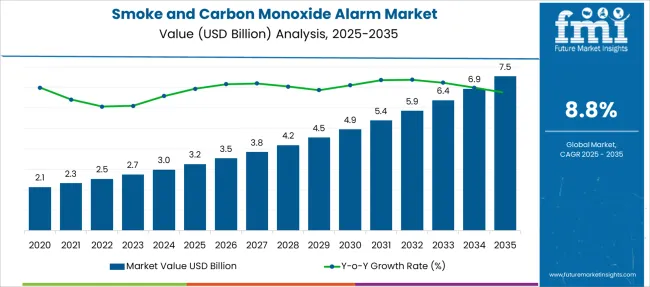
| Metric | Value |
|---|---|
| Smoke and Carbon Monoxide Alarm Market Estimated Value in (2025 E) | USD 3.2 billion |
| Smoke and Carbon Monoxide Alarm Market Forecast Value in (2035 F) | USD 7.5 billion |
| Forecast CAGR (2025 to 2035) | 8.8% |
The smoke and carbon monoxide alarm market is experiencing robust growth due to rising safety consciousness among homeowners and increasing mandates for life safety equipment in both new constructions and retrofit projects. Advancements in microelectronic sensors, improved battery life, and integration with smart home ecosystems are reshaping product innovation within this market. Governments and fire safety authorities across various regions have issued building codes and compliance standards that now require the installation of these alarms in residential, hospitality, and commercial buildings.
The demand has further been strengthened by increased awareness campaigns, insurance incentives, and the shift toward DIY security systems. Compact designs and mobile app connectivity have enhanced user engagement and convenience, thereby boosting the replacement cycle.
As energy efficiency and cost control become critical priorities for households, the adoption of battery-powered, maintenance-light alarm systems is expected to surge The market outlook remains positive, with continued traction expected in both emerging economies and developed markets due to a growing focus on affordable, scalable, and intelligent fire safety solutions.
The market is segmented by Power Source, Sensor Type, Price Range, and Sales Channels and region. By Power Source, the market is divided into Battery and Wired. In terms of Sensor Type, the market is classified into Ionized, Photoelectric, and Others. Based on Price Range, the market is segmented into Economy, Mid-Range, and Premium. By Sales Channels, the market is divided into Wholesalers/Distributors, Specialty Stores, Multi-Brand Stores, Independent Small Stores, Online Sales Channel, and Others. Regionally, the market is classified into North America, Latin America, Western Europe, Eastern Europe, Balkan & Baltic Countries, Russia & Belarus, Central Asia, East Asia, South Asia & Pacific, and the Middle East & Africa.
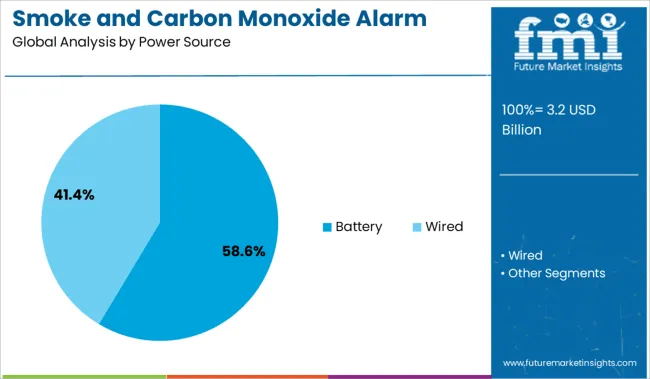
The battery power source segment is expected to hold 58.6% of the total revenue share in the smoke and carbon monoxide alarm market in 2025, positioning it as the leading segment. This growth is being driven by increasing consumer demand for flexible, wire-free installation options, particularly in residential and rental properties. Battery-operated alarms have gained strong preference due to their ease of installation, portability, and minimal disruption to existing infrastructure.
Improvements in battery technology, including the widespread use of lithium cells with extended lifespans, have reduced the need for frequent replacements and maintenance. The elimination of dependency on electrical wiring has also made these devices more suitable for retrofitting and temporary installations, thereby broadening their applicability.
Moreover, battery-powered alarms have become integral to DIY smart home systems, allowing users to integrate fire and gas detection seamlessly with mobile alerts and home automation platforms This combination of affordability, simplicity, and growing interoperability with digital platforms continues to strengthen the demand for battery-based solutions.
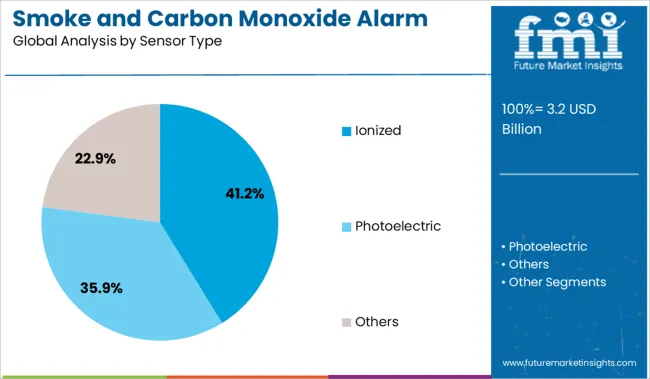
The ionized sensor type segment is projected to contribute 41.2% of the total revenue share in the smoke and carbon monoxide alarm market in 2025. This segment’s strength lies in its superior sensitivity to fast-flaming fires, making it suitable for environments where rapid fire detection is critical. Ionization alarms utilize a small amount of radioactive material to detect changes in air ionization, enabling quicker detection of invisible combustion particles produced by flaming fires.
Despite increasing attention toward photoelectric sensors, ionized technology remains favored in many standard safety applications due to its relatively lower cost and proven track record. The simplicity of design and ability to operate efficiently in various environmental conditions have preserved its relevance in residential and commercial settings.
Manufacturers have continued to invest in improving the safety and stability of ionization chambers while enhancing integration with dual-sensor configurations The segment is expected to sustain its share as part of broader multi-sensor systems that combine affordability with rapid fire responsiveness.
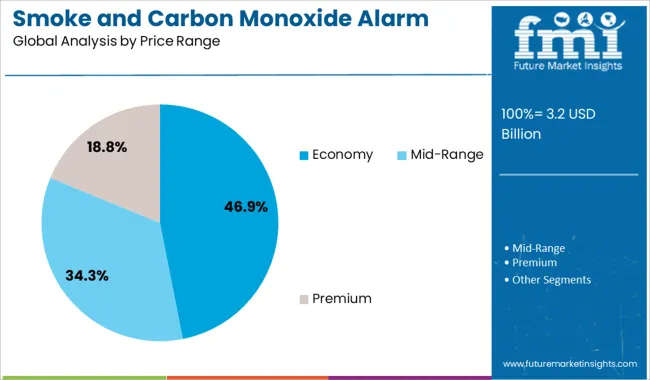
The economy price range segment is expected to account for 46.9% of the revenue share in the smoke and carbon monoxide alarm market in 2025, making it the largest pricing category. This dominance is being propelled by the increasing need for basic fire safety solutions in low to mid-income households, rental units, and cost-sensitive infrastructure projects. Economical alarms offer reliable core functionalities without premium features, making them an attractive choice for large-scale compliance-based installations.
Their affordability has facilitated widespread adoption, especially in regions where regulatory enforcement has expanded but budgetary constraints remain a barrier to premium options. Continuous advancements in low-cost sensor manufacturing and efficient production techniques have allowed brands to deliver dependable alarm systems at competitive prices without compromising on essential safety standards.
Government-backed subsidy programs and building code mandates have also incentivized the installation of these products in public housing and institutional settings The value-driven appeal of this segment ensures its continued relevance in supporting fire safety access across a broader population base.
A rise in government initiatives regarding fire safety awareness and technological advancements in smoke and carbon monoxide alarms are the key drivers positively influencing the growth of the smoke and carbon monoxide alarm market. Increasing spending on the infrastructural safety of commercial segments is propelling the market's growth.
On the other hand, the rise in disposable income in the Asia Pacific region and the Middle East and Africa is increasing the installation of smoke and carbon monoxide alarms in residences are some of the factors expanding the demand for smoke and carbon monoxide during the forecast period.
Continuous innovation and features added such as temperature sensors, high battery backup in the product, and other features added in smoke and carbon monoxide alarm are key trends adopted by the smoke and carbon monoxide alarm market players.
Increasing e-commerce penetration in developing countries and a rise in promotional activities by manufacturers are expected to positively influence the smoke and carbon monoxide alarm market sales during the forecast period.
Increasing urbanization, innovative city projects, and expanding spending on mall infrastructure in developing countries such as India, Brazil, Mexico, and others are expected to register new growth opportunities for the smoke and carbon monoxide alarm vendors during the forecast period.
North America is expected to hold a significant share of the global smoke and carbon monoxide alarm market due to the presence of a significant amount of players in the region. Moreover, technological advancement pertaining to infrastructural safety is positively influencing the growth of the smoke and carbon monoxide alarm market in the region; this pushes the sales of smoke and carbon monoxide alarms.
The smoke and carbon monoxide alarm market in Europe is expected to hold a significant value share in the global market due to a large number of manufacturing industries and corporate offices.
The rapid growth of the economy of countries in the Asia Pacific region, such as China, India, and others, is witnessing significant growth in the smoke and carbon monoxide alarm market in the region.
Players in the smoke and carbon monoxide alarm market are penetrating Latin America due to increasing industrialization, rise in per capita spending, and growing urbanization in the region, fueling the demand for smoke and carbon monoxide alarms.
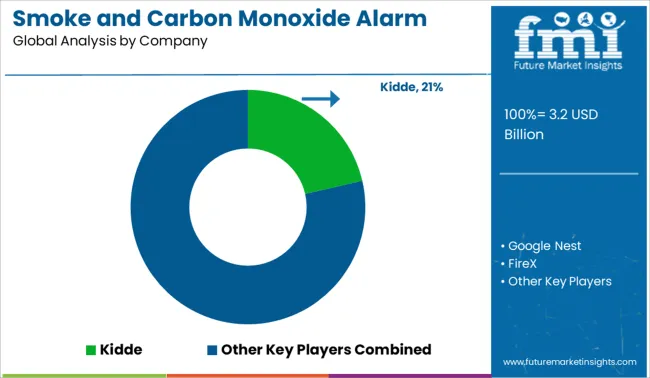
The key players in the Smoke and carbon monoxide alarm market are focusing on mergers and collaborations that are fueling the sales of Smoke and carbon monoxide alarms.
Key players in the Smoke and carbon monoxide alarm market include Kidde, Google Nest, FireX, FireAlert, Public Service Enterprise Group Incorporated, Onelink, Berkshire Hathaway, Safewire, Rishil World, Myalarmcenter, Vivint, Protect America and ADT Security Services.
Recent Market Development
| Report Attribute | Details |
|---|---|
| Growth Rate | CAGR of 5.8% from 2025 to 2035 |
| The base year for estimation | 2024 |
| Historical data | 2020 to 2024 |
| Forecast period | 2025 to 2035 |
| Quantitative units | Revenue in USD Billion, volume in kilotons, and CAGR from 2025 to 2035 |
| Report Coverage | Revenue forecast, volume forecast, company ranking, competitive landscape, growth factors, and trends, Pricing Analysis |
| Segments Covered | Power Source, Sensor Type, Price Range, Sales Channel, End Use |
| Regional scope | North America; Western Europe; Eastern Europe; Middle East; Africa; ASEAN; South Asia; Rest of Asia; Australia; and New Zealand |
| Country scope | USA, Canada, Mexico, Germany, United Kingdom, France, Italy, Spain, Russia, Belgium, Poland, Czech Republic, China, India, Japan, Australia, Brazil, Argentina, Colombia, Saudi Arabia, United Arab Emirates(UAE), Iran, South Africa |
| Key companies profiled | Kidde; Google Nest; FireX; FireAlert; Public Service Enterprise Group Incorporated; Onelink; Berkshire Hathaway; Safewire; Rishil World; Myalarmcenter; Vivint; Protect America; ADT Security Services |
| Customization scope | Free report customization (equivalent to up to 8 analysts' working days) with purchase. Addition or alteration to country, regional & segment scope. |
| Pricing and purchase options | Avail customized purchase options to meet your exact research needs. |
The global smoke and carbon monoxide alarm market is estimated to be valued at USD 3.2 billion in 2025.
The market size for the smoke and carbon monoxide alarm market is projected to reach USD 7.5 billion by 2035.
The smoke and carbon monoxide alarm market is expected to grow at a 8.8% CAGR between 2025 and 2035.
The key product types in smoke and carbon monoxide alarm market are battery and wired.
In terms of sensor type, ionized segment to command 41.2% share in the smoke and carbon monoxide alarm market in 2025.






Our Research Products

The "Full Research Suite" delivers actionable market intel, deep dives on markets or technologies, so clients act faster, cut risk, and unlock growth.

The Leaderboard benchmarks and ranks top vendors, classifying them as Established Leaders, Leading Challengers, or Disruptors & Challengers.

Locates where complements amplify value and substitutes erode it, forecasting net impact by horizon

We deliver granular, decision-grade intel: market sizing, 5-year forecasts, pricing, adoption, usage, revenue, and operational KPIs—plus competitor tracking, regulation, and value chains—across 60 countries broadly.

Spot the shifts before they hit your P&L. We track inflection points, adoption curves, pricing moves, and ecosystem plays to show where demand is heading, why it is changing, and what to do next across high-growth markets and disruptive tech

Real-time reads of user behavior. We track shifting priorities, perceptions of today’s and next-gen services, and provider experience, then pace how fast tech moves from trial to adoption, blending buyer, consumer, and channel inputs with social signals (#WhySwitch, #UX).

Partner with our analyst team to build a custom report designed around your business priorities. From analysing market trends to assessing competitors or crafting bespoke datasets, we tailor insights to your needs.
Supplier Intelligence
Discovery & Profiling
Capacity & Footprint
Performance & Risk
Compliance & Governance
Commercial Readiness
Who Supplies Whom
Scorecards & Shortlists
Playbooks & Docs
Category Intelligence
Definition & Scope
Demand & Use Cases
Cost Drivers
Market Structure
Supply Chain Map
Trade & Policy
Operating Norms
Deliverables
Buyer Intelligence
Account Basics
Spend & Scope
Procurement Model
Vendor Requirements
Terms & Policies
Entry Strategy
Pain Points & Triggers
Outputs
Pricing Analysis
Benchmarks
Trends
Should-Cost
Indexation
Landed Cost
Commercial Terms
Deliverables
Brand Analysis
Positioning & Value Prop
Share & Presence
Customer Evidence
Go-to-Market
Digital & Reputation
Compliance & Trust
KPIs & Gaps
Outputs
Full Research Suite comprises of:
Market outlook & trends analysis
Interviews & case studies
Strategic recommendations
Vendor profiles & capabilities analysis
5-year forecasts
8 regions and 60+ country-level data splits
Market segment data splits
12 months of continuous data updates
DELIVERED AS:
PDF EXCEL ONLINE
Smoke Alarm Market Trends- Growth & Industry Outlook 2025 to 2035
Carbon Monoxide Analyzers Market
Carbon Capture and Sequestration Market Forecast Outlook 2025 to 2035
Carbon Dioxide Incubators Market Size and Share Forecast Outlook 2025 to 2035
Carbon Enhanced Lead Acid Battery Market Size and Share Forecast Outlook 2025 to 2035
Carbon-negative Cement Market Size and Share Forecast Outlook 2025 to 2035
Carbon Tetrabromide Market Size and Share Forecast Outlook 2025 to 2035
Carbon Steel Market Size and Share Forecast Outlook 2025 to 2035
Carbon Brush Market Size and Share Forecast Outlook 2025 to 2035
Carbon Offset Platform Market Size and Share Forecast Outlook 2025 to 2035
Carbon Tapes Market Size and Share Forecast Outlook 2025 to 2035
Carbon-Free Waste Gas Abatement System Market Size and Share Forecast Outlook 2025 to 2035
Carbon Labeled Packaged Meal Market Analysis - Size and Share Forecast Outlook 2025 to 2035
Carbon Fiber Bike Wheelset Market Size and Share Forecast Outlook 2025 to 2035
Carbon Dioxide Lasers Market Size and Share Forecast Outlook 2025 to 2035
Carbon-negative Packaging Market Size and Share Forecast Outlook 2025 to 2035
Carbon Fiber Construction Repair Market Size and Share Forecast Outlook 2025 to 2035
Carbon Credit Market Size and Share Forecast Outlook 2025 to 2035
Carbon-Dioxide Synthesis Cosmetics Market Size and Share Forecast Outlook 2025 to 2035
Carbon-Neutral Skincare Ingredients Market Analysis - Size and Share Forecast Outlook 2025 to 2035

Thank you!
You will receive an email from our Business Development Manager. Please be sure to check your SPAM/JUNK folder too.
Chat With
MaRIA